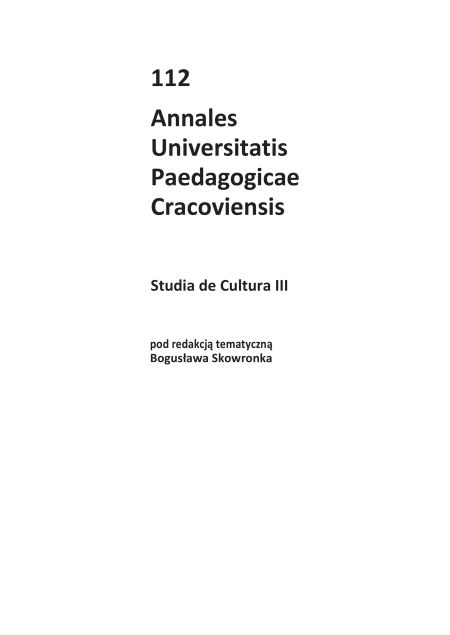Abstract
A photograph and a story in Leszek Szaruga’s narrative (his novel "A Photograph")
Leszek Szaruga’s novel is built by two interweaving narrative sequences which may be arbitrarily called photographic and historical ones. Photography and history function here through literature, in a closed off and finite semiotic system - constituted by a novel. It is literature which establishes the scope of reference for them. A photograph here is repeatedly a part of somebody’s story (by inscribing itself into the anthology of private narratives), while a story is somebody’s “photograph” (by inscribing itself into the album taken from history archives). Historic qualities of photography and, conversely, photographic ones of history determine each other mutually. A photograph presenting starving people in Africa triggers a character’s reflection, whereas co-existence of beauty and terror in a photograph makes him embark on a number of actions: photographing the photograph, or optical enlarging of its details. This, in turn, seems to constitute a kind of simulation of participating in the presented events which indicates taking up a hermeneutical game with reality. 20th century history of Poland, viewed from a perspective of the 1990s, is being written out for a set of life histories of people who represent different generations, thus forming a historic narrative chain in the novel. The novel’s polylogue on historical topics, as well as reflection revealed by the character under the influence of the viewed photograph create a dynamic anthropological project based on an assumption that being outside history is utopia, while existence means activeness, consciousness, and responsibility.
References
Biedrzycki M. (1998), Genetyka kultury, Kraków.
View in Google Scholar
Byliniak M. (2009), Krytyka obrazu w poezji i eseistyce Witolda Wirpszy, „Twórczość”, nr 8, s. 54–82.
View in Google Scholar
Grądziel-Wójcik J. (2001), Poezja jako teoria poezji. Na przykładzie twórczości Witolda Wirpszy, Poznań.
View in Google Scholar
Gutorow J. (2007), Urwany ślad. O wierszach Wirpszy, Karpowicza, Różewicza i Sosnowskiego, Wrocław.
View in Google Scholar
Owczarek B. (1999), Poetyka powieści niefabularnej, Warszawa.
View in Google Scholar
Jentys M. (2009), Obszar przemiany, „Twórczość”, nr 1, s. 87–90.
View in Google Scholar
Jesiółkowski J. (2009), Fotografia jako perswazja, w: Sztuki wizualne jako nośniki ideologii, red. M. Lisiecki, Toruń, s. 43–57.
View in Google Scholar
Kałuża A. (2008), Witold Wirpsza: anielska maszyna, w: tejże, Wola odróżnienia. O modernistycznej poezji Jarosława Marka Rymkiewicza, Julii Hartwig, Witolda Wirpszy i Krystyny Miłobędzkiej, Kraków, s. 147–186.
View in Google Scholar
Rouillé A. (2007), Fotografia. Między dokumentem a sztuką współczesną, przeł. O. Hedemann, Kraków.
View in Google Scholar
Soulages F. (2007), Estetyka fotografii. Strata i zysk, przeł. B. Mytych-Forajter, W. Forajter, Kraków.
View in Google Scholar
Stiegler Bernd (2009), Obrazy fotografii. Album metafor fotograficznych, przeł. J. Czudec, Kraków.
View in Google Scholar
Szaruga L. (1999), Historia, państwo, literatura, Polska powieść współczesna jako przestrzeń pytań o sens procesów dziejowych, Szczecin.
View in Google Scholar
Szaruga L. (2001), Współczesna powieść polityczna. Sens literatury, sens historii, Warszawa.
View in Google Scholar
Szaruga L. (2008), Zdjęcie, Szczecin.
View in Google Scholar
Traba R. (2006), Historia – przestrzeń dialogu, Warszawa.
View in Google Scholar
Traba R. (2009), Przeszłość w teraźniejszości. Polskie spory o historię na początku XXI wieku, Poznań.
View in Google Scholar
Wirpsza W. (1962), Komentarze do fotografii, Kraków.
View in Google Scholar
Wojak M. (2009), Po drugiej stronie kliszy, „Wyspa. Kwartalnik Literacki”, nr 1, s. 94–96.
View in Google Scholar
Zalewski C. (2010), Pragnienie, poznanie, przemijanie. Fotograficzne reprezentacje w literaturze polskiej, Kraków.
View in Google Scholar

